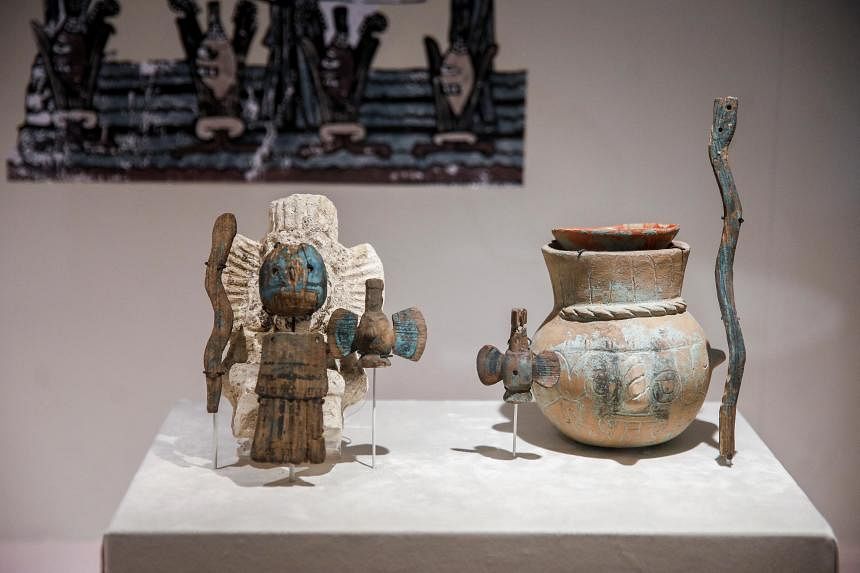
Most of the pieces on display were excavated from the ruins of the Aztec’s holiest shrine, now adjacent to the site of the Mexican capital’s Templo Mayor Museum.
PHOTO: REUTERS
UPDATED
SEP 30, 2023,
MEXICO CITY - A museum exhibit displaying Aztec ritual offerings dug up from underneath downtown Mexico City opened on Friday in a first-ever showcase that offers new insight into pre-Hispanic art and religious practices.
The artifacts, all crafted from wood, include finely carved masks, sculpted scepters believed to have been wielded by ancient gods, and weapons that were buried with sacrificed animals dressed as deities and warriors, both male and female.
Reuters gained exclusive access to the exhibit before it opened.
Most of the pieces on display were excavated from the ruins of the Aztec’s holiest shrine, now adjacent to the site of the Mexican capital’s Templo Mayor Museum.
Many were found in sealed stone boxes, buried over five centuries ago.
“These are very fragile objects, very delicate,” said exhibit curator Maria Barajas, standing next to a lineup of small carved masks.
“(Many) of them show warriors that died in battle,” she said. “You can see their eyes are half open, even the mouth is open.”
Most wooden artifacts quickly decompose and can only withstand the test of the time with constant temperature and moisture levels, Ms Barajas said.
Preserving them involves replacing the remaining moisture inside the wood with synthetic sugars so the artifacts do not disintegrate, a process that can take up to a year. The exhibit’s displays are also equipped with strict humidity controls.
Traces of original paint can still be seen on some of the artifacts, including a piece carved from copal resin that features wooden adornments painted in blue and depicting a mythical helper of the Aztec rain god Tlaloc. It holds a serpent scepter evoking the crack of lightning on one side, and a tiny water jug on the other.
“When they wanted to make it rain, (they) break the jars with the scepter and the water pours out,” said exhibit curator Adriana Sanroman, who is also head of restoration for the ongoing Templo Mayor excavations.
Another pair of scepters include tiny life-like hands that Sanroman says belonged to the god of death, Mictlantecuhtli.
“This is a god that’s (usually shown) in a state of partial decomposition, partially fleshless, and so he carries body parts here and there,” she said.
Along with the latest additions, the exhibit also features well-known Aztec wooden masterpieces on loan from other museums, including an exquisitely carved drum and a life-size sculpture depicting the god of pulque, the Aztecs’ favorite alcoholic drink.
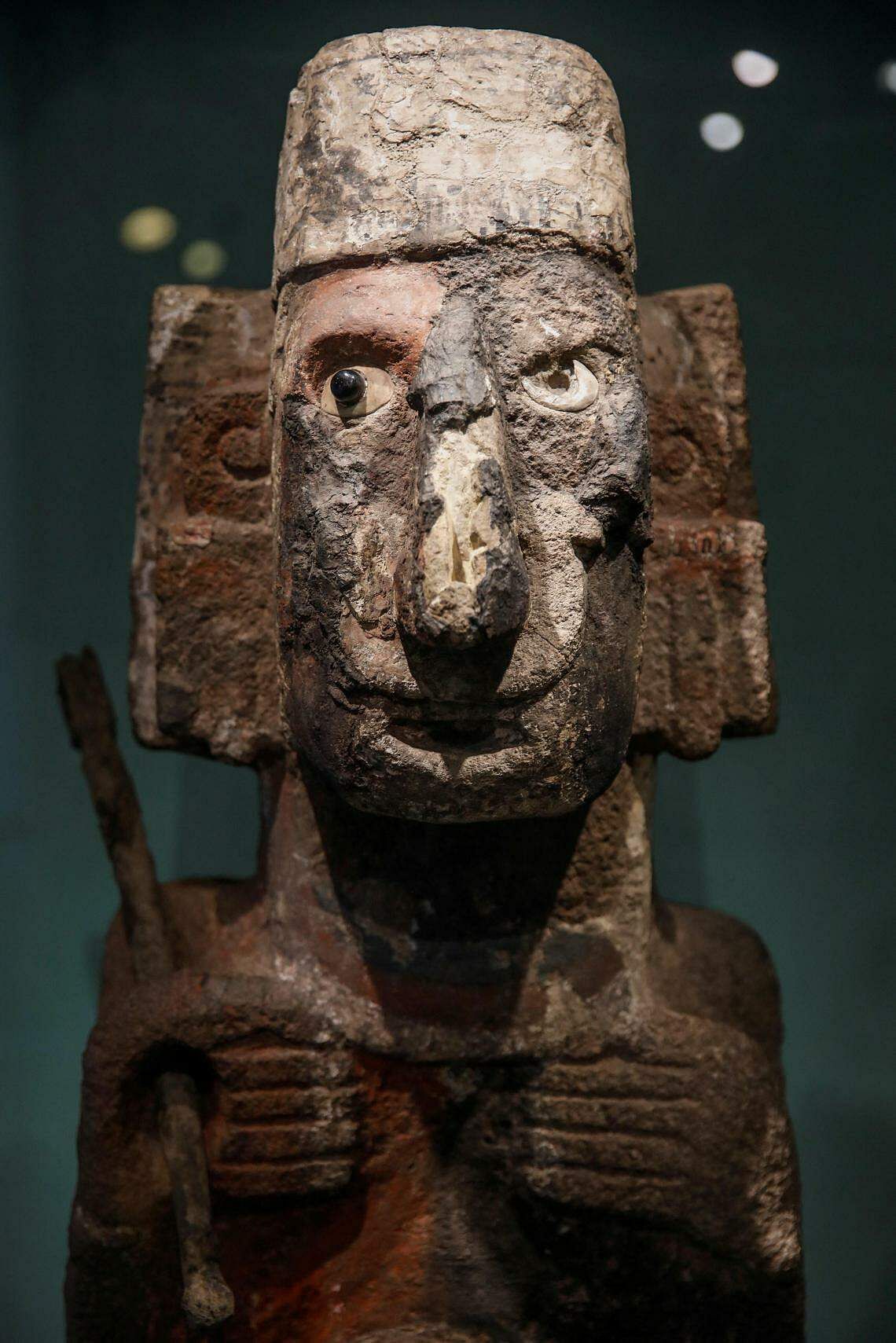
UPDATED
SEP 30, 2023,
MEXICO CITY - A museum exhibit displaying Aztec ritual offerings dug up from underneath downtown Mexico City opened on Friday in a first-ever showcase that offers new insight into pre-Hispanic art and religious practices.
The artifacts, all crafted from wood, include finely carved masks, sculpted scepters believed to have been wielded by ancient gods, and weapons that were buried with sacrificed animals dressed as deities and warriors, both male and female.
Reuters gained exclusive access to the exhibit before it opened.
Most of the pieces on display were excavated from the ruins of the Aztec’s holiest shrine, now adjacent to the site of the Mexican capital’s Templo Mayor Museum.
Many were found in sealed stone boxes, buried over five centuries ago.
“These are very fragile objects, very delicate,” said exhibit curator Maria Barajas, standing next to a lineup of small carved masks.
“(Many) of them show warriors that died in battle,” she said. “You can see their eyes are half open, even the mouth is open.”
Most wooden artifacts quickly decompose and can only withstand the test of the time with constant temperature and moisture levels, Ms Barajas said.
Preserving them involves replacing the remaining moisture inside the wood with synthetic sugars so the artifacts do not disintegrate, a process that can take up to a year. The exhibit’s displays are also equipped with strict humidity controls.
Traces of original paint can still be seen on some of the artifacts, including a piece carved from copal resin that features wooden adornments painted in blue and depicting a mythical helper of the Aztec rain god Tlaloc. It holds a serpent scepter evoking the crack of lightning on one side, and a tiny water jug on the other.
“When they wanted to make it rain, (they) break the jars with the scepter and the water pours out,” said exhibit curator Adriana Sanroman, who is also head of restoration for the ongoing Templo Mayor excavations.
Another pair of scepters include tiny life-like hands that Sanroman says belonged to the god of death, Mictlantecuhtli.
“This is a god that’s (usually shown) in a state of partial decomposition, partially fleshless, and so he carries body parts here and there,” she said.
Along with the latest additions, the exhibit also features well-known Aztec wooden masterpieces on loan from other museums, including an exquisitely carved drum and a life-size sculpture depicting the god of pulque, the Aztecs’ favorite alcoholic drink.

An anthropomorphic wooden sculpture depicting the Aztec god of pulque is pictured as part of the exhibition "Insignia of the Gods, the wood in the Templo Mayor," at the Templo Mayor Museum in Mexico City. PHOTO: REUTERS
Even though the Aztecs were known as fierce warriors before falling to Spanish invaders and their native allies in 1521, only one original Aztec sword survives.
The sword, also on display in the exhibit, is a flat wooden club with a groove where razor-sharp obsidian - a type of volcanic glass - would have been wedged in.
Stressing the artifacts’ fragility and scarcity, museum director Patricia Ledesma said the new exhibit gives a glimpse into an ancient world where wood was routinely transformed into high art.
“This allows us to begin to realize the sheer magnitude of all the marvelous things pre-Hispanic hands could do with this material.”
Even though the Aztecs were known as fierce warriors before falling to Spanish invaders and their native allies in 1521, only one original Aztec sword survives.
The sword, also on display in the exhibit, is a flat wooden club with a groove where razor-sharp obsidian - a type of volcanic glass - would have been wedged in.
Stressing the artifacts’ fragility and scarcity, museum director Patricia Ledesma said the new exhibit gives a glimpse into an ancient world where wood was routinely transformed into high art.
“This allows us to begin to realize the sheer magnitude of all the marvelous things pre-Hispanic hands could do with this material.”
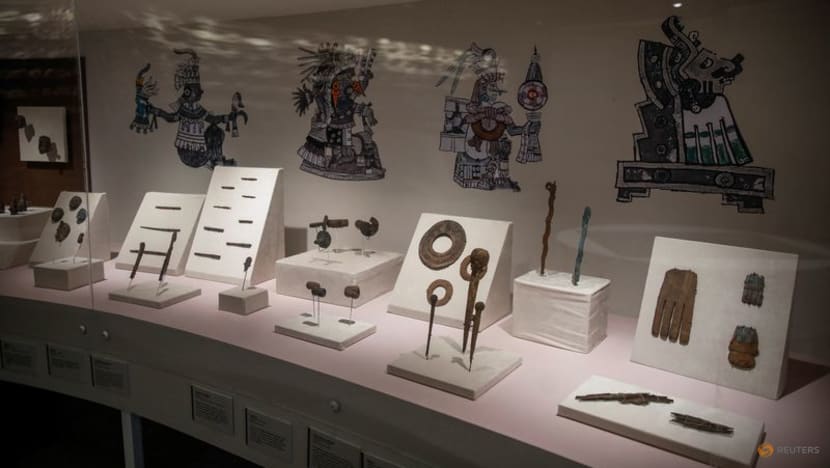
Recently excavated Aztec ritual offerings carved from wood are pictured, including chest plates, scepters and ear flares, part of the exhibition "Insignia of the Gods, the wood in the Templo Mayor," at the Templo Mayor Museum in Mexico…see more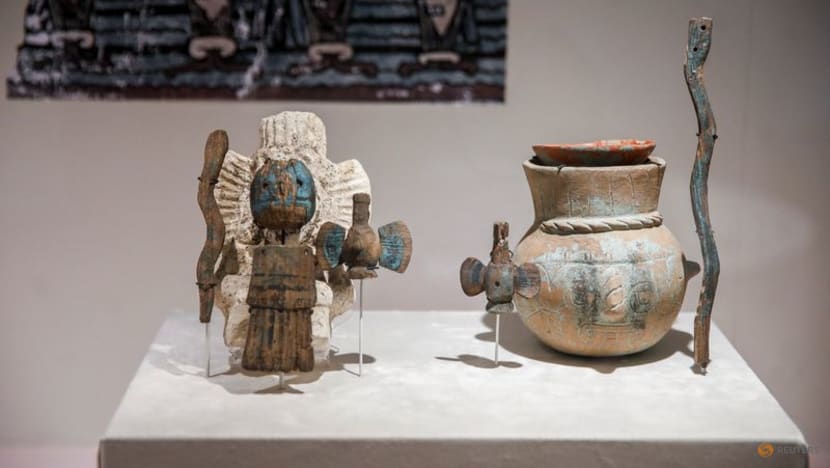

A carved copal figure depicting a tlaloque, or helper of the Aztec rain god Tlaloc, is pictured (left) along with its wooden mask, scepter and water jugs, next to a Tlaloc modeled ceramic pot (right) with similar adornments, part of the…see more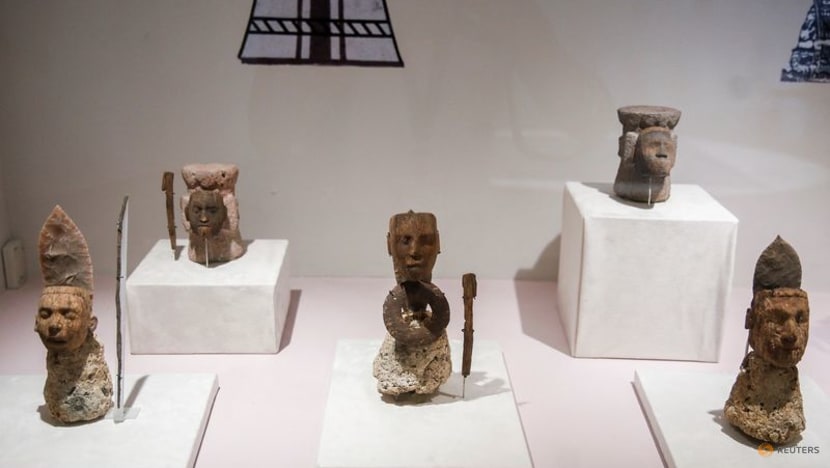

Small sculptures evoking warriors and warfare made from wood, copal and flint are pictured as part of the exhibition "Insignia of the Gods, the wood in the Templo Mayor," at the Templo Mayor Museum in Mexico City, Mexico September 27

Recently excavated Aztec ritual offerings carved from wood are pictured, including chest plates, scepters and ear flares, part of the exhibition "Insignia of the Gods, the wood in the Templo Mayor," at the Templo Mayor Museum in Mexico…see more

A carved copal figure depicting a tlaloque, or helper of the Aztec rain god Tlaloc, is pictured (left) along with its wooden mask, scepter and water jugs, next to a Tlaloc modeled ceramic pot (right) with similar adornments, part of the…see more

Small sculptures evoking warriors and warfare made from wood, copal and flint are pictured as part of the exhibition "Insignia of the Gods, the wood in the Templo Mayor," at the Templo Mayor Museum in Mexico City, Mexico September 27,…see more

Recently excavated Aztec ritual offerings carved from wood are pictured, including chest plates, scepters and ear flares, part of the exhibition "Insignia of the Gods, the wood in the Templo Mayor," at the Templo Mayor Museum in Mexico
REUTERS
No comments:
Post a Comment